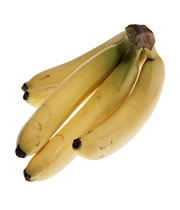 |  | 
Published online: 15 October 2006; | doi:10.1038/news061009-13
Even black-and-white bananas look yellowExperiment reveals how expectation interferes with perception.Ayla Arslan 

| What colour are your bananas? Most people see a tinge of yellow even when the picture is grey. Getty |
|
When we look at a banana, does our brain tell us it looks yellow, even if it isn't? A recent study shows that it does.
Psychologists at the University of Giessen, Germany, report in Nature Neuroscience that our perception of an object's colour depends on our memory of its typical colour.
Karl
Gegenfurtner and his co-workers showed their subjects digitized images
of fruit, presented in random colours against a grey background. They
then asked observers to adjust the colour of the fruit on the computer
screen until it too was grey.
Bananas are yellow
But
the volunteers had a hard time doing this. With a picture of a banana,
for example, they would adjust the colour to be slightly too blue when
trying to achieve grey, as if compensating for a perception of yellow
that wasn't really there (blue is opposite yellow on the colour wheel).
At the point at which the banana was truly achromatic, volunteers
thought it still looked a bit yellow.
It
made no difference what colour the picture of the banana started as.
Volunteers might be struck or amused by the image of a red banana, says
Gegenfurtner, but they still kept a yellow banana in mind.
When
volunteers were shown a neutral shape — a uniformly coloured disk, for
example — this problem disappeared: observers could accurately make it
grey.
Grass is greener
Previous
studies have also shown that our minds can play tricks on us when it
comes to colour. We may remember colours as being more intense than
they really were, for example. Volunteers asked to pick out the colour
of grass from a variety of green cards often choose one that is
'greener' than real grass, says Gegenfurtner.
One study has even shown that we discriminate colour differently when it is seen to our left versus to the right (see 'Language colours vision').
Gegenfurtner says the new study highlights how memory of a colour can also have an impact on its perception.
Visit our newsblog to read and post comments about this story.
References
-
Hansen
T.,
et al. Nature Neurosci., doi:10.1038/nn1794 (2006).
|
|  | 
Story from news@nature.com:
http://news.nature.com//news/2006/061009/061009-13.html |
|  |
|